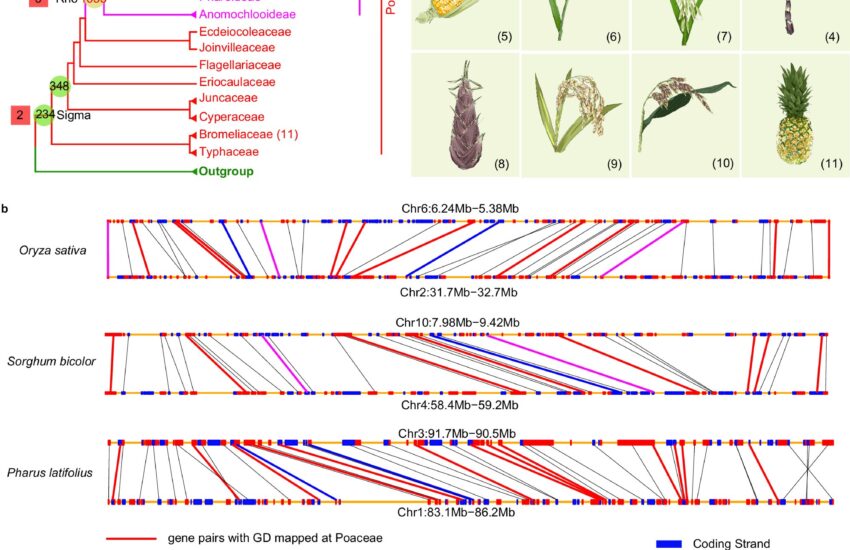
Grasses cover about 40% of the Earth’s land surface, thriving in a multitude of environments. The evolutionary success of this plant family, which includes rice, maize, wheat and bamboo, likely results from a history of whole-genome duplications, according to a new analysis led by Penn State biologists.
A paper describing the research appeared in the journal Nature Communications.
The research team compared the genomes from a diverse selection of over 350 species of grass species, building backwards to form a picture of what the ancestral grass genome might have looked like.
They provided large-scale gene duplication information for a known whole-genome duplication that is shared by all the grasses—an event referred to as rho, which resulted in the ancestral grass cells containing two copies of the organism’s genetic information.
The team also identified additional, more recent whole-genome duplications in specific lineages and tracked which duplicated genes were retained or lost in individual species, which the researchers said may have contributed to the diversification of grasses.
“Different species of organisms can sometimes mate and produce offspring, a process called hybridization,” said Hong Ma, Huck Chair in Plant Reproductive Development and Evolution and professor of biology in the Penn State Eberly College of Science and the leader of the research team.
“In animals, the offspring are often sterile, like when horses and donkeys mate to produce mules. This sterility is often due to problems in dividing up the two genomes when making sperm and egg cells. In plants, hybridization occurs much more frequently and the resulting hybrids can survive and reproduce, making whole-genome duplications more common.”
When a whole-genome duplication occurs as a result of a hybridization, the resulting plant will have two copies of all genes. The duplicated genes may be slightly different, having come from the two different species that hybridized, but because only one copy is needed, the other copy is said to be redundant, which means that it is free to evolve without much risk of negative impacts.
“Most of the time if a gene experiences a mutation, it will negatively impact the function of the gene,” Ma said.
“But when you have duplicated genes, one of them can change more freely while the other maintains its function. In this way, duplicated genes are often the raw material for evolutionary adaptation. Sometimes the DNA repair mechanisms in the cell will make the two copies more similar—a process called gene conversion. Sometimes one copy will be lost altogether and sometimes one copy will evolve a new function.”
In previous research, Ma and his team built a more complete phylogeny, or family tree, of the grasses. This better understanding of relationships among grass species allowed them to follow duplicated gene pairs in related species, seeing where they were lost, retained or evolved.
“It’s kind of like molecular paleontology,” Ma said. “Each modern species has undergone evolutionary change that can obscure the history of genome duplications, but with a large number of species we can see more and more pieces of that history in order to reconstruct it. It’s like finding bones from different individual dinosaurs to reconstruct a more complete picture of the entire skeleton.”
To better understand the known rho whole-genome duplication shared across all grasses, the research team identified genes involved in environmental adaptations that were differentially retained among grass subfamilies.
This includes a gene for adaptation to aquatic environments in rice; a gene for cold adaption in the subfamily that includes wheat, barley, oats and rye; a gene for rapid cell growth in bamboo; and a gene for drought response in maize.
The team also identified nine previously unknown whole-genome duplication events among individual lineages of grasses.
“Grasses have been extremely successful at colonizing a wide variety of environments around the world,” Ma said.
“With our improved understanding of the relationships among grasses, we can see how important whole-genome duplication events were to this success and begin to identify the genes that were retained or lost in individual species that allowed this diversification.
“This information could also help guide selective breeding efforts in crop plants to take advantage of the natural adaptations that allow grasses to thrive in such varied environments.”
More information:
Taikui Zhang et al, Phylogenomic profiles of whole-genome duplications in Poaceae and landscape of differential duplicate retention and losses among major Poaceae lineages, Nature Communications (2024). DOI: 10.1038/s41467-024-47428-9
Provided by
Pennsylvania State University
Citation:
How duplicated genomes helped grasses diversify and thrive (2024, August 1)
retrieved 3 August 2024
from https://phys.org/news/2024-08-duplicated-genomes-grasses-diversify.html
This document is subject to copyright. Apart from any fair dealing for the purpose of private study or research, no
part may be reproduced without the written permission. The content is provided for information purposes only.

